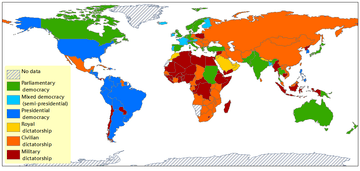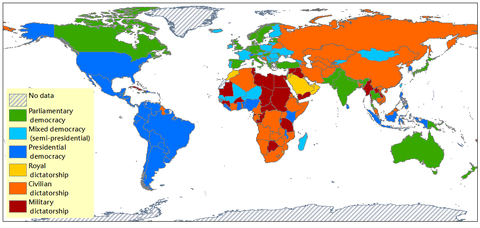Democracy-Dictatorship Index


Democracy-Dictatorship (DD)[1], index of democracy and dictatorship[2] or simply the DD index[3] or the DD datasets refers to the binary measure of democracy and dictatorship first proposed by Adam Przeworski et al. (2010), and further developed and maintained by Cheibub, Gandhi, and Vreeland (2009).[4]
Based on the regime binary classification idea proposed by Alvarez in 1996[5], and the Democracy and Development (or DD measure, ACLP datatset) proposed by Przeworski et al. (2010), Cheibub, Gandhi, and Vreeland developed a six-fold regime classification scheme, resulting what the authors called as the DD datasets.[1]:68
The DD dataset covers the annual data points of 199 countries from 1946 (or date of independence) to 2008.[1]:68 The figures at the left show the results in 1998 and 2008.
Six-fold regime classification scheme and its rules
The DD index first classifies the regimes into two types: democracies and dictatorships. For democracies, it categorizes them into three types: parliamentary, semi-presidential and presidential democracies. For dictatorships, monarchic, military and civilian dictatorship.[1]
Based on a “minimalist” theory of democracy, the index relies on rules regarding the existence of competitive elections.[1][3] Resorting to democratic concepts by Karl Popper and Joseph Schumpeter, Przeworkski defended the minimalist approach, citing Popper that "the only system in which citizens can get rid of governments without bloodshed."[6]
Four rules
For a regime to be considered as a democracy by the DD scheme, it must meet the requirement of four rules below:[1]:69[3]
- The chief executive must be chosen by popular election or by a body that was itself popularly elected.
- The legislature must be popularly elected.
- There must be more than one party competing in the elections.
- An alternation in power under electoral rules identical to the ones that brought the incumbent to office must have taken place.
Some regimes may meet the first three rules, but lack an alternation in power in its historical past; these regimes are classified as dictatorships and marked with a type II value, signalling potential classification errors where a democratic regime may be falsely classified as dictatorship[1]:70.
The authors acknowledged that the last rule is more complicated to implement but argued that it helps researchers to control potential errors and enhance the classification schemes' scientific reproducibility.[1]:70
In DD dataset, the Type II variable does not indicate cases of semi-democracy or cases of semi-dictatorship.[1]:71.
The regimes with type2 value of 1 (2008)
For the regimes with type2 of 1, the following list compares the similarities and contrasts between the 2008 data points from the DD dataset and the Polity IV.[1]
| Continent | subregions | Regimes | Polity datasets IV | Polity datasets IV category | DD dataset code | DD dataset category | DD dataset type2 |
|---|---|---|---|---|---|---|---|
| Asia | Southern Asia | -66 | Anocracies, special | 3 | Civilian dictatorship | 1[note 1] | |
| Asia | Western Asia | -7 | Autocracies | 3 | Civilian dictatorship | 1[note 1] | |
| Africa | Western Africa | 0 | Anocracies | 4 | Military dictatorship | 1[note 1] | |
| Africa | Southern Africa | 8 | Democracies | 4 | Military dictatorship | 1[note 1] | |
| Africa | Middle Africa | -1 | Anocracies | 4 | Military dictatorship | 1[note 1] | |
| Africa | Middle Africa | -4 | Anocracies | 3 | Civilian dictatorship | 1[note 1] | |
| Africa | Middle Africa | 5 | Anocracies | 3 | Civilian dictatorship | 1[note 1] | |
| Africa | Middle Africa | -4 | Anocracies | 4 | Military dictatorship | 1[note 1] | |
| Africa | Northern Africa | 2 | Anocracies | 3 | Civilian dictatorship | 1[note 1] | |
| Africa | Northern Africa | -3 | Anocracies | 4 | Military dictatorship | 1[note 1] | |
| Africa | Eastern Africa | -7 | Autocracies | 3 | Civilian dictatorship | 1[note 1] | |
| Africa | Eastern Africa | -3 | Anocracies | 3 | Civilian dictatorship | 1[note 1] | |
| Africa | Middle Africa | -4 | Anocracies | 3 | Civilian dictatorship | 1[note 1] | |
| Africa | Western Africa | -5 | Anocracies | 4 | Military dictatorship | 1[note 1] | |
| Africa | Middle Africa | -5 | Anocracies | 4 | Military dictatorship | 1[note 1] | |
| Americas | South America | 6 | Democracies | 3 | Civilian dictatorship | 1[note 1] | |
| Americas | Caribbean | 5 | Anocracies | 3 | Civilian dictatorship | 1[note 1] | |
| Asia | Central Asia | -6 | Autocracies | 3 | Civilian dictatorship | 1[note 1] | |
| Asia | South-Eastern Asia | 2 | Anocracies | 3 | Civilian dictatorship | 1[note 1] | |
| Africa | Southern Africa | 8 | Democracies | 3 | Civilian dictatorship | 1[note 1] | |
| Europe | Southern Europe | 9 | Democracies | 3 | Civilian dictatorship | 1[note 1] | |
| Africa | Eastern Africa | 5 | Anocracies | 3 | Civilian dictatorship | 1[note 1] | |
| Asia | South-Eastern Asia | 6 | Democracies | 3 | Civilian dictatorship | 1[note 1] | |
| Africa | Southern Africa | 6 | Democracies | 3 | Civilian dictatorship | 1[note 1] | |
| Europe | Eastern Europe | 4 | Anocracies | 3 | Civilian dictatorship | 1[note 1] | |
| Africa | Eastern Africa | -3 | Anocracies | 4 | Military dictatorship | 1[note 1] | |
| Asia | South-Eastern Asia | -2 | Anocracies | 4 | Military dictatorship | 1[note 1] | |
| Africa | Eastern Africa | N/A | N/A | 3 | Civilian dictatorship | 1[note 1] | |
| Africa | Middle Africa | -2 | Anocracies | 4 | Military dictatorship | 1[note 1] | |
| Africa | Western Africa | -4 | Anocracies | 3 | Civilian dictatorship | 1[note 1] | |
| Asia | Central Asia | -3 | Anocracies | 3 | Civilian dictatorship | 1[note 1] | |
| Oceania | Polynesia | N/A | N/A | 5 | Royal dictatorship | 1[note 1] | |
| Africa | Northern Africa | -4 | Anocracies | 4 | Military dictatorship | 1[note 1] | |
| Africa | Eastern Africa | -1 | Anocracies | 4 | Military dictatorship | 1[note 1] | |
| Africa | Eastern Africa | -1 | Anocracies | 3 | Civilian dictatorship | 1[note 1] | |
| Asia | Central Asia | -9 | Autocracies | 3 | Civilian dictatorship | 1[note 1] | |
| Oceania | Polynesia | N/A | N/A | 5 | Royal dictatorship | 1[note 1] | |
| Asia | Western Asia | -2 | Anocracies | 4 | Military dictatorship | 1[note 1] | |
| Africa | Southern Africa | 9 | Democracies | 3 | Civilian dictatorship | 1[note 1] | |
| Africa | Eastern Africa | 7 | Democracies | 3 | Civilian dictatorship | 1[note 1] | |
| Africa | Eastern Africa | -4 | Anocracies | 3 | Civilian dictatorship | 1[note 1] |
Comparison with other democracy-measuring data sets
The DD dataset is limited to 199 countries after 1946, whereas Boix, Miller, & Rosato, 2013 proposed a data set from 1800 to 2007, covering 219 countries. The 2010 version of Polity data series covers 189 countries from 1800 to 2009.[7]
Gugiu & Centellas developed the Democracy Cluster Classification Index that integrates five democracy indicators (including the DD dataset, Polity dataset, etc.), clustering 24 American and 39 European regimes over 30 years.[2]
See also
Notes
References
- 1 2 3 4 5 6 7 8 9 10 11 12 Cheibub, José Antonio; Gandhi, Jennifer; Vreeland, James Raymond (April 2010). "Democracy and dictatorship revisited". Public Choice. Springer. 143 (1–2): 67–101. doi:10.1007/s11127-009-9491-2. JSTOR 40661005.
- 1 2 Ristei, Mihaiela; Centellas, Miguel (Summer 2013). "The Democracy Cluster Classification Index". Political Analysis. Oxford Journals. 21 (3): 334–349. doi:10.1093/pan/mpt004.
- 1 2 3 William R. Keech (14 October 2013). Economic Politics in the United States. Cambridge University Press. pp. 17–. ISBN 978-1-107-00414-6. Retrieved 24 March 2014.
Specifically, the DD index (for Democracy and Dictatorship) assesses the United States as a democracy from 1946, the first measured, through 2008, the last year of measurement. ... My definition of a democracy is minimalist, like the DD definition of Cheibub, Gadhi, and Vreeland (2010), but it adds a dimension. Like DD, it considers the presence of contested elections a necessary condition of ....
- ↑ Haggard, Stephan; Kaufman, Robert R. (August 2012). "Inequality and regime change: democratic transitions and the stability of democratic rule". American Political Science Review. Cambridge Journals. 106 (3): 495–516. doi:10.1017/S0003055412000287.
- ↑ Alvarez, M.; Cheibub, J. A.; Limongi, F.; & Przewroski, A. (1996). "Classifying political regimes". Studies in Comparative International Development. 31 (2): 3–36. doi:10.1007/bf02719326.
- ↑ Przeworkski, Adam (2003). "Minimalist Conception of Democracy: A Defense". In Robert Alan Dahl, Ian Shapiro& José Antônio Cheibub. The Democracy Sourcebook. MIT Press. p. 12. ISBN 978-0-262-54147-3. Retrieved 24 March 2014.
- ↑ Boix, Carles; Miller, Michael; Rosato, Sebastian (December 2013). "A complete data set of political regimes, 1800–2007". Comparative Political Studies. Sage. 46 (12): 1523–1554. doi:10.1177/0010414012463905.
External links
- DD dataset and citations
- ACLP datsset and citations
- Przeworski, Alvarez, Cheibub, and Limongi: Democracy and development From WikiSummary, the Free Social Science Summary Database